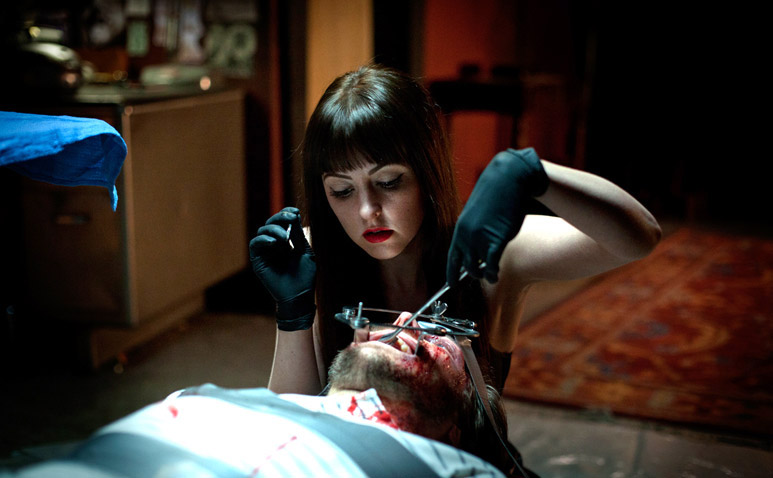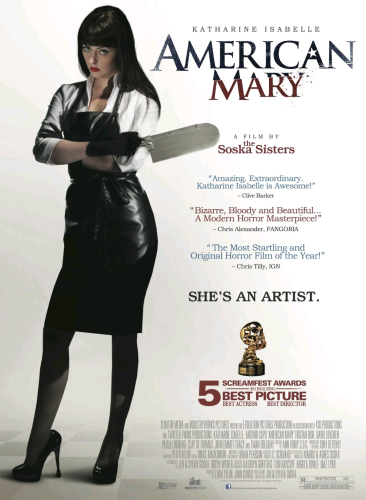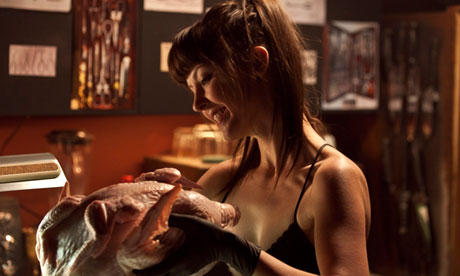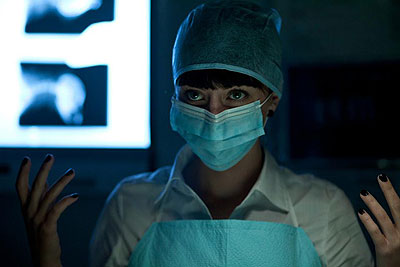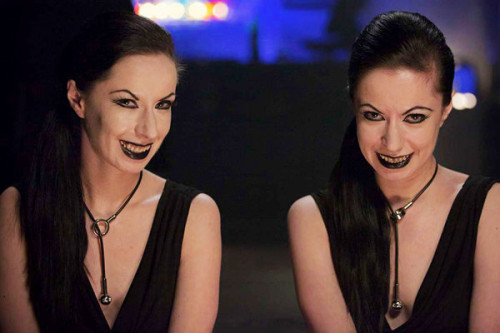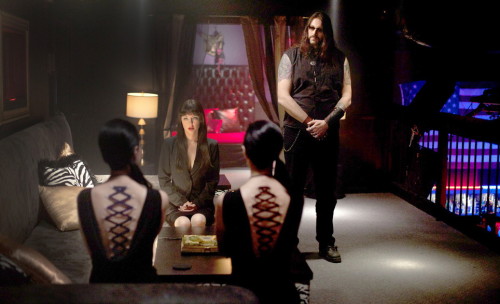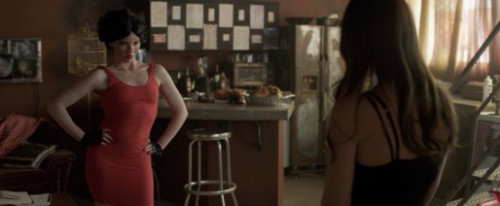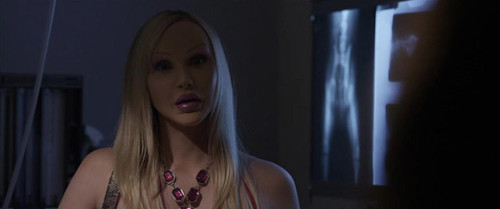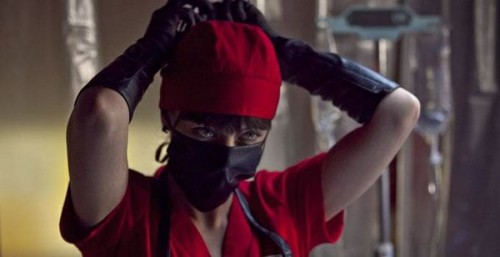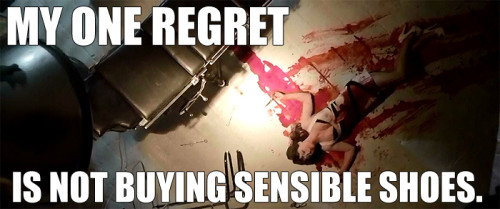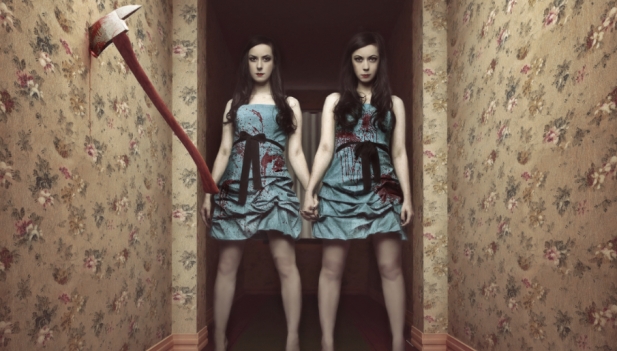
To get an idea of the Soska sisters, picture The Shining’s Grady twins, only all grown up and in control of their destinies.
As kids, Jen and Sylvia Soska were drawn to horror movies, fascinated by the spectacle of the genre and the mystique of the Final Girl. When they grew up, they tried acting, only to find the roles they were offered as a set identical twin actresses, were either infantilizing or fetishistic.
Fed up, they wrote, directed and starred in Dead Hooker in a Trunk , a low-budget strike-out at the constraints they faced in film school. Next came cult favorite, American Mary, a dark journey through the world of body modification and the controversial rape-revenge genre. One of my personal favourite horror movies, American Mary features a fascinating central character in Mary Mason (Katherine Isabelle), who morphs from anxious med-student to a cold as ice antihero we can’t help but root for, even as she becomes a monster.
Their new film See No Evil 2, a sequel to the 2006 WWE Studios production, See No Evil, is an entertaining and well-thought out slasher flick that knows the genre conventions well enough to simultaneously play around with them and celebrate their fun. All the familiar elements from the sisters’ previous films are there: three dimensional female characters, gore and gleeful violence, splashes of humour, and a Hitchcock-style cameo, now paired with the terrifying figure of wrestler Glenn “Kane” Jacobs, a longtime favorite of the sisters, as the hulking serial killer, Jacob Goodnight.
Just in time for Halloween, the Soska sisters spoke with us about their favorite horror movies, the hardships of working as female directors in masculine genre, their work on See No Evil 2 and what’s next for their careers.
Bitch Flicks: What horror films do you remember scaring or affecting you as children?
Sylvia: Poltergeist– it was our first horror film that was the catalyst to our mum explaining how filmmaking really works and us falling deeply in love with the genre. I remember The Stand was the next thing to really scare the shit out of me. I saw Hellraiser at a very young age, but I was so into prosthetics that it was just beautiful to me.
Jen: Alien, too. I remember being so scared at the end and my mum telling me not to worry because Ripley always wins. I was witnessing the evolution of the final girl without even knowing it.
BF: How did you realize you could create your own films?
S: By being pushed to the point where we made a punk rock FU in the form of a short film faux trailer called Dead Hooker in a Trunk. We are life long failed actresses that wanted to use our martial arts experience to get into stunt work that ended up in a crappy film school which was for us the last straw. They took away our budget for our final project, so we decided to write, direct, produce, star in, and do the stunt work for our own project. We were annoyed so we made sure to make it as batshit insane and offensive as possible. And come graduation night, it played to half the audience walking out and the other half cheering so loud you could barely hear the crass dialogue. That was what started it.
J: Robert Rodriguez and his book Rebel Without a Crew was a huge influence, too. Rodriguez has his epic Ten Minute Film School segments where he shows filmmakers how to do what he does in his films. I used to think I wanted to be an actor before I realized how much more fulfilling directing and writing is. You get to create this whole world, and stories, and characters. As an actor you’re usually chasing work you don’t even want just to be working.

BF: Can you tell me about the change from being actresses to filmmakers in charge of your own productions? Was the change empowering?
S: It was so empowering. Neither of us are fans of labeling, but being twins – people just put you in this box. As kids, it was cutesy, talk at the same time stuff, as we grew older it became overtly sexual, talk at the same time stuff. As we got into our twenties, we knew we wanted to do something different. I love watching films and always fantasized about what I would do if I could make films, I never thought it could be a reality. To have the job of creating the characters that we do and making the films that we do is an amazing opportunity.
J: It felt like coming home. In a weird way all the skills we had that we didn’t think had anything to do with one another just came together. I love filmmaking. We’re natural story tellers so being able to turn our ideas, concepts, and characters to the big screen is the most unbelievable feeling.
BF: Why are you drawn to horror? What came first, an interest in filmmaking or in horror? Did you seek out horror or fall into the genre due to its accessibility to low budget production?
S:I never even realized the effect horror films had on me until I went into filmmaking. I see all of my interests like horror films, comic books, video games, and wrestling reflected in what I do now because I grew up on that stuff and it moulded me into the strange individual I am today. The reason why DHIAT was low budget was because we didn’t know how hard or expensive making a movie would be. We read Rebel Without a Crew, we saw Grindhouse in the theaters a million times and thought, yup, we gotta make a feature film called Dead Hooker in a Trunk. We have to do that.
J: I’ve loved horror movies as far back as I can remember. It’s definitely not because it can be done inexpensively at even a low level. Surely documentaries and dramas are even easier to do on a small budget. Horror is just so much fun. You go to horror film festivals or conventions and you find the happiest, most out going people in the world. People who are into horror just seem to be happier, nicer people. Maybe it’s because we get out all our aggression on the screen, ha ha
BF: Have you ever wanted to experiment with a different genre?
S: Absolutely. It started with us wanting to tackle every sub genre within horror – so far we have body horror and slasher, maybe grindhouse if you really want to stretch the genre, and I don’t know what our ABCs of Death 2 segment, T is for Torture Porn, would be categorized as. We are just in post production on our first action film, part of the WWE Studios and Lionsgate Film Action Six Pack Series, called Vendetta, starring Dean Cain, Paul “Big Show” Wight, and Michael Eklund. It’s the macho-est thing we have ever done – it’s very gritty and super violent.
J: We definitely want to tackle each and every sub genre in horror. I wouldn’t say there’s really any genre we wouldn’t want to take on. It all depends on the project. We’d even make a kids movie if they’d ever let us, ha ha. I’d really love to make a Western. We’ll be doing our first comic book adaptation when we bring Jimmy Palmiotti’s Painkiller Jane to the big screen.
BF: Can you tell me a bit about some of your influences?
S: I adore Lars Von Trier’s work, it’s so unforgivingly bleak yet beautiful what he does. Takeshi Miike is just a master of tone and gore. Mary Harron is my hero, seeing her speak was the reason why I wanted to be a director – she’s so eloquent and her films deliver such a punch. We learned how films got made from Robert Rodriguez – we adore his work!
J: I love Joss Whedon. His writing, humor, characters, and story arcs are just incredible. I’ve loved him since he worked on Roseanne, but it was Buffy that really made me fall for him and his stereotype breaking, unconventional characters. And his out of nowhere, heart breaking favorite character deaths.
BF: Do you ever experience any prejudice or roadblocks as women in horror? Has that effected your sensibility? Difficulty getting funding?
S: Always and I think it might be forever. No matter how many cool people are out there, there will be hateful people that are bigoted, cruel, and disrespectful. We paid for our first film, my parents – who are the most wonderful and supportive people on the planet – re-mortgaged their home to invest in American Mary so it could happen, and then there came Lionsgate and WWE Studios who loved our stuff and wanted to team up to make some cool films. Getting funding is difficult, there are some misogynistic pricks out there but there are also a lot of cool people who don’t suck at life; with our time working with these studios – we got cool people who were funding the projects.
J: Oh, sure. But sexism is an issue much bigger than the film industry. I’ve encountered it everywhere I’ve worked and usually paired with ageism. We’ve never encountered it from someone who is actually successful and happy with their lives. It’s more often miserable people, often ones who somehow failed forward and are wanna be filmmakers themselves who end up just resenting us.

BF: Do you feel your films have a female sensibility? What other horror films do you feel might have a female sensibility? What would your dream film be?
S: Definitely, but it’s because Jen and I don’t believe in disposable characters. Everyone who exists in one of our films is important and unique. I think it comes from our acting days when we’d find ourselves going for roles that were lame just because we wanted to be working. Some awesome horror films with female sensibility would be Stoker, Excision , Spring , Martyrs, Inside, and Audition. You really get to see real, flawed female characters taking centre stage in these very amazing films. Being Hungarian, the dream project that we really want is Elizabeth Bathory, the Blood Countess.
J: You can kill a hundred people in a film and have it not connect at all with the audience or you can kill a single person in a very real and emotional way. I think women have more of an eye for suffering. I totally agree with Sylv. It would be such a thrill to bring the Hungarian Murderess, Elizabeth Bathory.
BF: Do you feel you have a certain responsibility as female directors working in horror? Why is it important to have a female voice in horror?
S: Yes, because there are so few of us working. Not because there is a lack of female directors, but a serious lack of female directors being hired. Thank God you have directors like Jovanka Vuckovic making Clive Barker’s Jacqueline Ess and Kathryn Bigelow kicking ass all kinds of ass, and this is the same filmmaker that made the amazingly bro-tastic Point Break. That said, I want to see more. When you don’t have the perspective of half your population weighing in artistically there is a problem. There are too many stories not being told.
J: I wish I had more female role models growing up. The directors I loved that had the biggest influence on me were all male directors. John Carpenter, David Cronenberg, Clive Barker, Quentin Tarantino, David Lynch… It’s really important for us to do well so that other little girls can be inspired to be filmmakers, too. We need to hear more female voices.
BF: You’ve set out to cast women in lead roles in your films. Dead Hooker in the Truck was originally intended for an all women cast. There are several prominent female characters in See No Evil 2. Why is this important to you? Why do you cast yourselves in your films?
S: I have watched too many two-dimensional throwaway female characters. I have read for too many of them. I think it’s time to see the modern woman reflected properly in our entertainment. I want to see as versatile and complicated characters as are traditionally given to leading men. We play a lot with gender stereotypes in our films. I think gender is a big issue right now, things are slowly starting to change, and I want to be a part of that. As for our own cameos in our films, it’s something we loved that Hitchcock used to do. That and kill blondes.
J: I spent too much of my acting days chasing after roles I didn’t really even want. The options out there for women, let alone identical twins, was incredibly limiting. I like to write the kind of roles I would have killed to play or even audition for. We don’t believe in throwaway characters. Everyone that’s there needs a purpose and to look hot isn’t enough of one. I love Joss Whedon’s answer to “why do you write strong women?” “Because you’re still asking me that.” Women are every bit as strong and complex and interesting as men, but that’s just not often reflected enough in the films we see coming out. Women have such a capacity for evil. Just check out David Fincher’s Gone Girl. It’s such a beautifully executed film.
BF: What is your process working together? Do you each tackle different things? How has working with a partner changed your approach or refined it?
S: Jen and I are born collaborators. We went to school together, we’ve always been roommates, we’ve shared the same jobs, we have collaboration down to a fine art in a creepy The Shining hive mind kind of way. We have similar interests, but we are very different people. We take different paths to get to the same place. It is definitely more refined now, we just know what needs to be done and just divide and conquer. Jen’s awesome to work with on set, I’m really lucky.
J: I’ve never not had a partner. I’m a twin. I’m very lucky to have been born with such a talented artist, best friend, and strong business partner. Sylv is awesome. She’s so darkly creative. We have the same sensibilities and humor, but we’re very different. We always arrive at the same goal, but the ways we get there are very different. We really do compliment each other.
BF: How has being twins shaped your careers? Twins are quite a horror trope in itself, has that influenced you in your lives and attraction to horror?
S: My whole life I’ve walked into rooms and hear people talk about us being twins. It’s cool, but I wanted to be something more than that and it’s proven to be a difficult task. We felt confidant that being filmmakers could be recognizable than being twins. I remember the first time I heard someone call us the Twisted Twins and I fucking loved it. We are definitely seen as a sideshow oddity, which doesn’t bother me. I’m a freak, I like freaks. I love being a twin. It seems sad to me to not have a twin.
J: I’ve gratefully never had to know what it’s like to not have a twin. It’s really the greatest thing ever. I feel sorry for anyone who doesn’t have a twin. Because we’re twins we have always stood out in a crowd and grew up with people staring at us. Being an identical twin is also like having a backstage pass to the greatest shit. You will definitely see duality in our films. We love symmetry, you can see it in our cinematography. We like to show two sides to each of our characters. We’ll repeat little things, lines, or actions. Often in foreshadowing.
BF: How do you feel about your reputation as cult favorites?
S: I feel like we showed up under-dressed and over-loud with these crazy films and some people totally got it and decided to support us; and other people just loathe our existence. I like that the people that do like our films really fucking like them, that’s more than you could ever ask for!
J: It’s an insane honor! I can’t believe it, it’s just so surreal. I’m so grateful. It’s so weird to me that all the stuff we were made fun of for liking and being into growing up are the things people really seem to like about us now. I think all us nerds just grew up and took over, ha ha.

BF: As horror films, your films feature a lot of violence against women, how do you feel about this? Is it empowering to shape these narratives yourselves with a female voice? For example, American Mary works as a rape revenge story and Dead Hooker in The Trunk features a prolonged flashback to the beating of a prostitute.
S: The prolonged death of the Hooker in DHIAT was made with the intention of being very difficult to watch. We didn’t create the term ‘Dead Hooker in a Trunk’, there is a society wide stigma on these women that devalue them as worthless human beings. When working girls go missing, people don’t really care. We wanted people to care about the Hooker, we wanted to show that yeah, there’s a lot of silly stuff in the film to laugh at, but when it comes to the physical destruction of this woman, it’s not a joke. We are at a point in time where we need to get a zero tolerance for horrendously vile acts against women. We put these moments in these films because we want to open up a dialogue about it and it’s a lot easier to do with a genre film than other platforms.
J: Mary had her morals compromised and her ideals of being one of the guys, one of the surgeons she so admired, destroyed steadily before the rape. That was just the last thing she believed in taken away from her. Her idol fallen in a big way. The reason we put violence against women in our films is because it is so common in real life. It’s so common that people just turn a blind eye to it. The amount of letters and emails we’ve received from women who’d been sexually assaulted and had their attacker go unpunished was disgusting. They were so happy to see Mary get her revenge because there is so little justice in the world.
BF: Can you tell me a bit about See No Evil 2 and how you got involved in it and working with WWE?
S: After American Mary, we took meeting after meeting to get to work on our next film, an original monster movie called BOB, but all they wanted to see was a watered down version of American Mary. It was getting depressing. People think after you have a critically acclaimed film everything just falls into place, it doesn’t. When we got the offer for See No Evil 2, we were super excited. We are huge WWE fangirls, we started watching when the Kane character was introduced, and it was a cool slasher – it was a dream project. Lionsgate and WWE have been incredibly supportive collaborative partners.
J: We really love horror and want to take on every sub genre in horror. Not too many directors get the opportunity to.
BF: What was it like approaching a story for a sequel rather than an original story and working with someone else’s script? How did you put your personal spin on the project?
S: It was really fun, but that’s in large part because of the writers, Nathan Brookes and Bobby Lee Darby, because they have very similar sensibilities to us. They are very rad Brits and that like to horribly murder people in their scripts. As soon as we got involved, we all got into the story, what we had, what we could do to push it more, it was a very collaborative process. Then you get Danielle Harris and Glenn ‘Kane’ Jacobs involved and the script evolves moreso. We got to put a lot of ourselves into the film – Tamara [Katherine Isabelle’s character] is Jen on a date.
J: Ha ha, only a good one. I’ve been known to take dates on Buffy~esque walks in the graveyard. I would be the first one to suggest going down to the morgue, especially to take a peek at Jacob Goodnight. It was important for all the characters to matter and be strong, but especially the girls. I like that we were able to continue on our signature of keeping our audiences guessing. I don’t want to spoil anything, so I won’t go into much more detail. You can definitely feel our humor and sensibilities in this one.
BF: What was it like working with Kane?
S: An amazing experience. As a fan, I had inhumanly high expectations on this hero I grew up watching. Somehow, he managed to be even better than that. Glenn is so professional, so hard working, and just a genuinely wonderful human being. He’s so smart, he brought so much to making this the next evolution of Jacob Goodnight, and he is so psychically capable that we could really show off his Hulk-strength in the film. I loved working with him. I actually cannot wait to work with him again, there’s a lot of roles someone like him can play.
J: Really a dream come true. A big part of why we were so excited to come onto the film was the opportunity to meet and work with Glenn. We started watching as he was introduced as Kane on WWE. To have our lives come so full circle is incredible. And so surreal. Glenn is an amazing performer as well as an athlete. He’s just fantastic to work with. I love him.

BF: How does See No Evil 2 fit in with your previous films?
S: I think the characters in See No Evil 2 could easily exist in a world where Badass and Mary Mason also live – there are from that same universe in our heads. It’s an art house slasher homage that is also very self aware – not many studios would let you do something like that with such a profitable franchise.
J: There’s a running theme in our films where seemingly everyday characters, people who could be you, me, our friends, get thrown into something life changing and end up getting tough and evolving. It’s very much the same in See No Evil 2. If you pay attention, you can also see the big beats for each character that also results in their outfits transforming more and more final girl as they go. We like to put a lot of heart in our films and you will care for these people that you see brutally murdered.
BF: You worked with Katharine Isabelle for a second time in See No Evil 2. Is it important to you to create a stable of actors and reliable people to work with again and again? She’s getting to a bit of a horror icon herself, as is Danielle Harris. Chelan Simmons has also been in her share of slashers. Can you tell me a bit about how you work with actors and what qualities make an actor fun to work with? Were these people you sought out to work with? Did you look to people with a reputation as horror icons?
S: We build a bit of a film family on these things, we have such an amazing crew in Vancouver – they are so good at what they do and they’ve been with us through so much, you will definitely see lots of names repeating in our various films. The same goes for the cast – you keep collaborating because there’s this magic that can happen as you keep getting more comfortable about each other. I love actors and the more I get to know them as people, the more I’m like, oh, they would be perfect doing this. Working with Katie on Mary, I got to know how ridiculously funny she is. You never see the hot girl also being the funniest one. Tamara came from us wanting to see that.
I know a lot of the actresses in SNE2 have done a ton of horror movies, that was intentional in the casting. We wanted a pedigree to the whole thing. It was so cool to work with Danielle and Chelan – they are just so good at what they do. I can’t wait to be able to work on the next thing with them. I know Danielle is about to direct her second feature and I cannot wait to see that. Can you imagine the kinds of films a woman like that will create? Badass.
J: We try to hunt down the very best people. People who love film and love what we’re doing. Life’s too short to work with dicks and it’s crazy to think people who work in film aren’t always super grateful to be where they are. We become very close with our cast and crew. They’re the people we call friends, some even family, like Katie. We love working with our friends. And actors are so capable. Just look at Michael Eklund. I could work with him on every film I do for the rest of my life and I know he’ll just keep surprising me and blowing us away with his performances.
S: We strive to build up that core. You see a lot of directors team up with the same talent because you become friends and want to do more and more with them and give them chances to play a range of different characters. I’m really so blessed to have been able to work with so many amazing people.
BF: A spoiler question…
You played with the concept of the Final Girl with the ending of See No Evil 2. How do you feel about the idea of the Final Girl?
S: I love the final girl so much. I have cheered many a Final Girl on in my living room, but I always see the Final Girl. We like playing with gender stereotypes, so Seth is the final boy. If you rewatch the film, he does all the final girl moments – love interest willing to die for to save, has an encounter with Jacob but survives, throughout loses more clothing for sexed up/battle damaged look (this was an intentional transition look for all of the cast), gives ‘everything is going to be ok’ speech, everyone else is dead, and the final impossible showdown. I hope we get to make three — Seth has more to do and Jacob’s still not dead.
J: I loved killing the Final Girl. And we killed one of horror’s true icons, Danielle Harris. She is the perfect final girl. We wanted to set up both Danielle and Katie as being potential final girls all the while building up our final boy, Seth, played by the wonderful Kaj-Erik Eriksen. Seth is a mix between Ash (Evil Dead) and Seymour (Little Shop of Horrors). He’s the hot, really sweet, nerd who turns out to be as tough as nails. I loved having him go head to head with Jacob Goodnight and just take all that damage.
BF: What projects do you have in the works at the moments?
S: There are a few things in development that we’re really excited about. A huge one is Painkiller Jane, written by Jimmy Palmiotti and Craig Weeden, which is a big screen adaptation of the badass graphic novel heroine. It’s one of the best scripts I’ve ever read – which makes sense because Jimmy co-created the character. It’s an honest to goodness, straight from the comic, foul languaged, super sexy, hardcore violent, kickass chick cop buddy movie with a superhuman flair. It’s like The Heat on crack.
J: We just finished up Vendetta, our first action movie starring Dean Cain, Paul “The Big Show” White, and Michael Eklund. I’m so happy with it. It’s like a Punisher movie taking place in a men’s prison. And you’ve never seen Dean Cain be this much of a badass. It’ll be out sometime in 2015. We’ve got quite a few things in development, including our high concept, original monster movie called, BOB. Nothing would make me happier than to be doing BOB next. It’s so weird and heart felt and honest and brutal and hilarious. I cannot wait to be making it.

Sylvia and Jen’s new film See No Evil 2 is currently available DVD and Blu-Ray as well as On Demand and Digital HD.
Elizabeth Kiy is a Canadian writer and journalist living in Toronto, Ontario.
